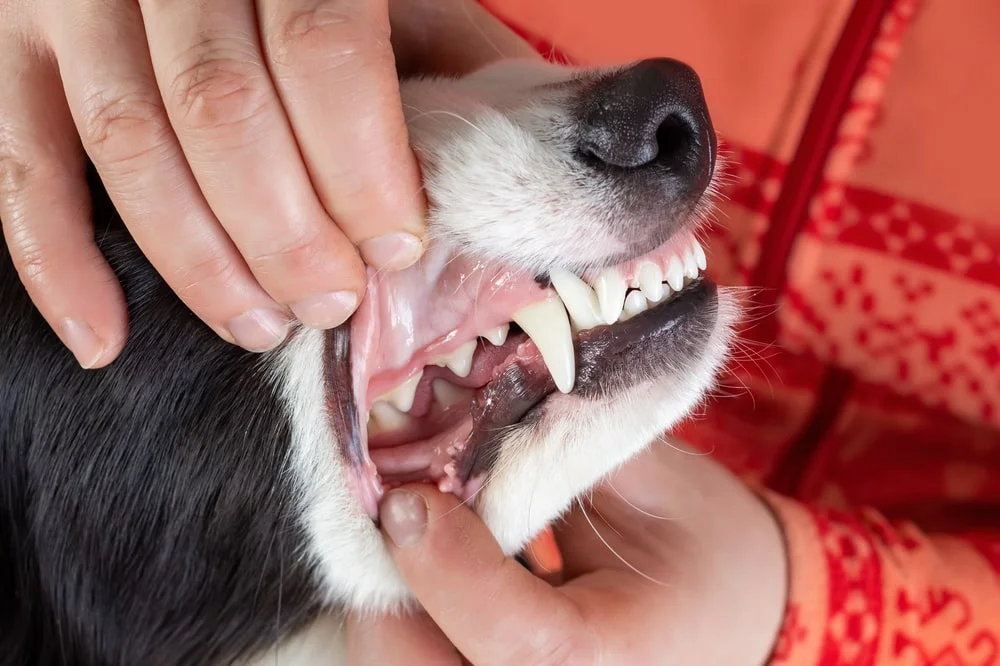PET HEALTH
You love your dog’s smile, so you don’t want to imagine anything being wrong with your canine’s canines. But even a dog with seemingly white, clean teeth can have a potentially devastating disease lurking in their mouth.
Periodontal disease in dogs is more common than you might imagine. In fact, there’s a good chance your pup may already have it. Learn how to identify dental disease in dogs and how it can be treated.
MetLife Pet Can Help You With Periodontal Disease Treatment Costs
What Is Periodontal Disease in Dogs and How Common Is It?
Periodontal disease, also called dental disease, is essentially a gum disease that occurs when bacteria from plaque cause inflammation in a dog’s gums, tissue, and bone.1
The plaque causes gaps between the teeth and gums known as periodontal pockets and, eventually, the disease destroys enough of the gums to put teeth at risk. This process can be extremely painful for dogs.1
Unfortunately, periodontal disease is very common in dogs. Experts believe 80% – 90% of dogs ages 3 or older have some form of periodontal disease.1
Since dental health is part of a dog’s overall health, dogs with periodontal disease may also be at a higher risk for developing other health issues — like heart, kidney, and liver disease.2 Even if periodontal disease doesn’t cause other issues for your dog, it can be costly to treat. A pet insurance policy with MetLife Pet can typically cover diagnosis, treatment, and cleanings associated with periodontal disease.
Symptoms of Periodontal Disease
Unfortunately, symptoms of dental disease in dogs don’t always appear right away. It’s possible you won’t notice your dog has periodontal disease until the disease has advanced. At this point, your dog may already be in pain.1,2
Being aware of these signs of periodontal disease in dogs can help you identify it and get the right treatment:2
- Pain
- Red, inflamed, or bleeding gums
- Tissue destruction
- Bone loss
- Tooth loss or loose teeth
- Difficulty chewing
- Decreased appetite
- Bad breath (halitosis)
- Excessive salivation
Causes of Dental Disease in Dogs
After a dog eats, food and bacteria collect along their gum line. This causes plaque to form, eventually hardening into tartar buildup that causes gingivitis (inflammation) and dental disease.3
Dogs who don’t have their teeth brushed daily or weekly at home can have additional plaque formation.1,2 This can make it even easier for dental disease to develop.
How To Treat Periodontal Disease in Dogs
Periodontal disease progresses through various stages and treatment depends on how advanced it is.
Stage 1 treatment
In stage one, your dog’s gums may be red and inflamed. Treatment typically involves a cleaning below and above the gum line from your vet, and brushing your dog’s teeth daily with a toothbrush can also be helpful.4
Many dogs are already out of this stage by the time they show more severe symptoms. This is why preventive veterinary cleanings from the time your dog is a puppy can be the key to catching periodontal disease early. However, dog teeth cleanings can cost between $300 and $700. But with MetLife Pet Insurance’s Preventive Care plan add-on, aspects of your dog’s oral health, like routine teeth cleanings, can be covered.
Stage 2 treatment
In stage two, there can be swelling and pockets between the gum and teeth, and there may be damage to the bone. In this stage, treatment typically involves a professional cleaning by your vet done under anesthesia.4
At this stage, further bone damage can still be prevented.4
Stage 3 treatment
In stage three, the pockets around the teeth are deep, meaning bone loss is usually occurring. Cleaning the tissue around the tooth root and the bone is necessary in this stage. Extraction may be required, but there are also newer treatments that promote the growth of new tissue and bone that you could explore by seeing a specialist. You’ll want to discuss options with your veterinarian.4
Stage 4 treatment
In stage four, the final stage of the disease, diagnosis is determined by how much damage has been done to the bone. Typically, the only treatment for stage 4 periodontal disease in dogs is removal or extraction of the affected teeth, which can cost between $500 and $2,500.4
Dental extraction may be expensive, but a pet insurance policy can help offset the costs. For example, when 7-year-old Mercedes needed a tooth extraction for periodontal disease, the amount billed was more than $600. His pet parents had a MetLife Pet Insurance plan, and they were reimbursed nearly $500 of the bill.5
Prevention of Periodontal Disease in Dogs
There are several proactive measures you can take when considering how to prevent periodontal disease in dogs:1,2,4
- Brush your dog’s teeth on a daily basis. Minimizing the bacteria present in your dog’s mouth will assist your dog in maintaining good oral health.
- Have annual veterinary teeth cleanings. Veterinarians recommend a yearly visit to check and clean a dog’s teeth. Oral exams and cleanings are done under general anesthesia, allowing your vet to take an up-close look at the health of your dog’s mouth.
- Feed your dog high-quality dog food. Proper nutrition from high-quality dog food can assist with reducing the risk of periodontal disease.6 If you feed your dog dry kibble, it helps in cleaning your dog’s teeth and increasing oral health. Of course, some dogs would rather eat canned food than dry dog food. If your dog prefers canned food, check out the next tip.
- Get some chew toys specifically designed for oral health. These can be a win-win — your dog gets some physical and mental stimulation, and dental chews can have oral benefits like potentially preventing plaque buildup. Greenies, for example, developed by Nutro Products Inc., assist with cleaning your dog’s teeth.7
Get Proactive About Your Dog’s Oral Health With Dog Insurance
No pet parent wants to see their dog in pain, but periodontal disease can be costly between diagnosis and treatment. MetLife Pet Insurance can help save you money on periodontal disease costs, and with our Preventive Care add-on for reimbursements on dental cleanings, you can boost your pup’s oral hygiene and help thwart periodontal disease.
MetLife Pet offers fully customizable policies so you can choose your reimbursement rate and deductible.8,9 That means you’ll be able to find a plan that fits your needs and your budget — no more worries about choosing between finances and your dog’s care.
Consider investing in a dog insurance policy to help keep your pup healthy and smiling bright. Get your free quote today.


